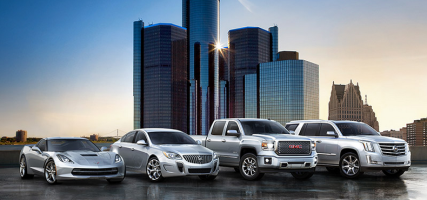GM has been nothing short of an extremely disappointing business (and investment) for more than a decade. Market share losses, chronically unprofitable operations, ballooning pension and healthcare obligations, safety issues, vehicle recalls, a massive government bailout during the financial crisis, and more have left investors’ skeptical of GM since its relisting in late 2010. More recently, uncertainty in China (GM’s second largest market) and a potentially peaking automotive market have created additional anxiety about making an investment in the company.

We think the new GM is a much healthier, structurally more competitive company that is attractively priced with a 4.5% dividend yield and a 2016 forward earnings multiple of about 6x. It never hurts to know that Berkshire Hathaway moderately increased its stake in the company over the past year either (see all of Warren Buffett’s dividend stock holdings Warren Buffett’s dividend stock holdings).
Business Overview
GM is one of the largest manufacturers of cars and trucks in the world, racking up total retail vehicle sales of 9.9 million in 2014. Its North American brands are Buick, Cadillac, Chevrolet, and GMC, and the company’s vehicle mix in the U.S. is 37% cars, 38% trucks, and 25% crossovers. Customers outside North America are also served by GM’s Holden, Opel, and Vauxhall brands, as well as brands owned by Asian entities GM has equity ownership stakes in. By geography, North America accounts for 55% of sales, Europe 19%, South America 15%, and Other International Markets 11%. China is GM’s second largest market (#1 by volume). In 2014, GM estimates it had the largest market share in North America and South America, the number six market share in Europe, and the number two market share in the Asia, Middle East, and Africa region.
GM’s dark past remains relatively fresh in the minds of most investors. The U.S. government spent about $50 billion to bail out GM during the financial crisis. During GM’s bankruptcy in 2009, the government’s investment was converted to a 61% equity stake in the company, plus preferred shares and a loan. The government started exiting its stake in late 2010 when GM was relisted and was completely out of the company by the end of 2013.
What led to the company’s bankruptcy? Essentially, GM’s union-driven labor costs kept it uncompetitive with foreign competitors and chronically unprofitable, the company’s debt load was out of control (GM had more than $2 of liabilities for every $1 of assets prior to going bust), it was selling too many brands to too many dealers, and the frozen credit markets after Lehman Brothers collapsed made it impossible for GM to raise money or sell non-core assets to stay afloat. The company had been restructuring its operations for more than four years before the crash, racking up over $80 billion in losses, but it didn’t help enough.
In reality, GM’s demise started long before the years leading up to the financial crisis. This history is important to understand because it provides perspective on the significance of the new GM’s improved operations, which we will discuss later on. If you rewind the clock back to the 1940s and 1950s, there was actually very little foreign auto competition in the United States. During these golden years, GM actually held over 50% of the light vehicle market compared to less than 20% today. With such dominance, the company was able to comfortably maintain labor peace by handing over big pensions, free health care coverage for life, annual cost-of-living pay hikes, and more to its workers. One of the more ridiculous benefits was the Jobs Bank, a concession made in the 1980s that entitled any laid off workers to be paid 95% of their salary until a new job could be found for them.
At the time, GM could still get away with this because of its massive scale compared to peers. However, it was starting to feel the effects. According to The Center for Automotive Research, GM was spending 50% more per hour on each worker compared to its Japanese counterparts, and the cost of retired works’ health benefits added more than $1,200 to the cost of each car compared to vehicles produced overseas. Higher labor costs made the production of lower-ticket, smaller vehicles basically unprofitable, yet GM needed to maintain high production levels to avoid layoffs (it still had to pay laid off workers 95% of their salary until they found a new job, remember?) and continue pumping its massive dealer network with inventory that had to be deeply discounted to sell. Not surprisingly, GM’s quality deteriorated and the company’s market share was steadily eroded for more than 30 years. The rise of lean manufacturing in Japan further exacerbated GM’s inefficiencies and lower quality products. The following chart shows GM’s share of the US light-vehicle market from the early 1980s through 2008.











Leave A Comment